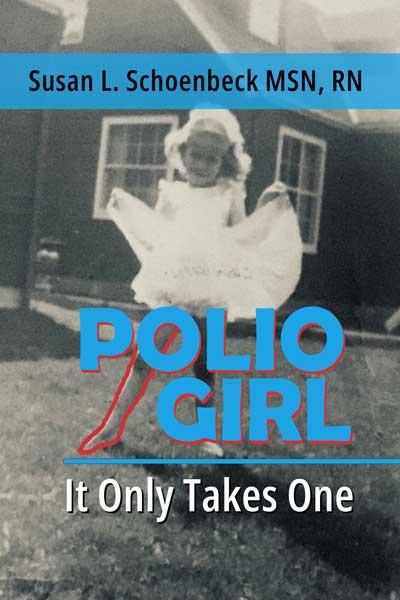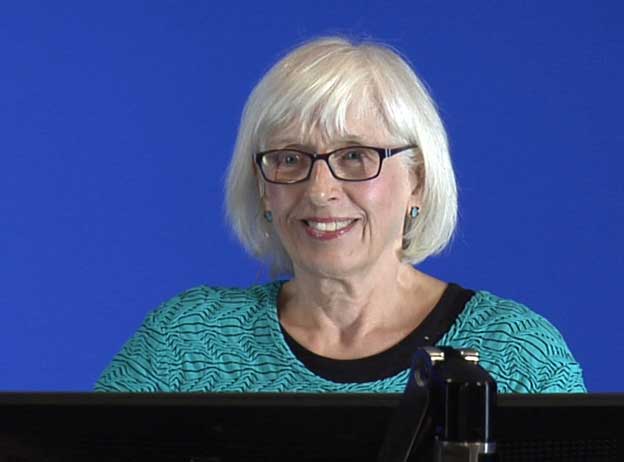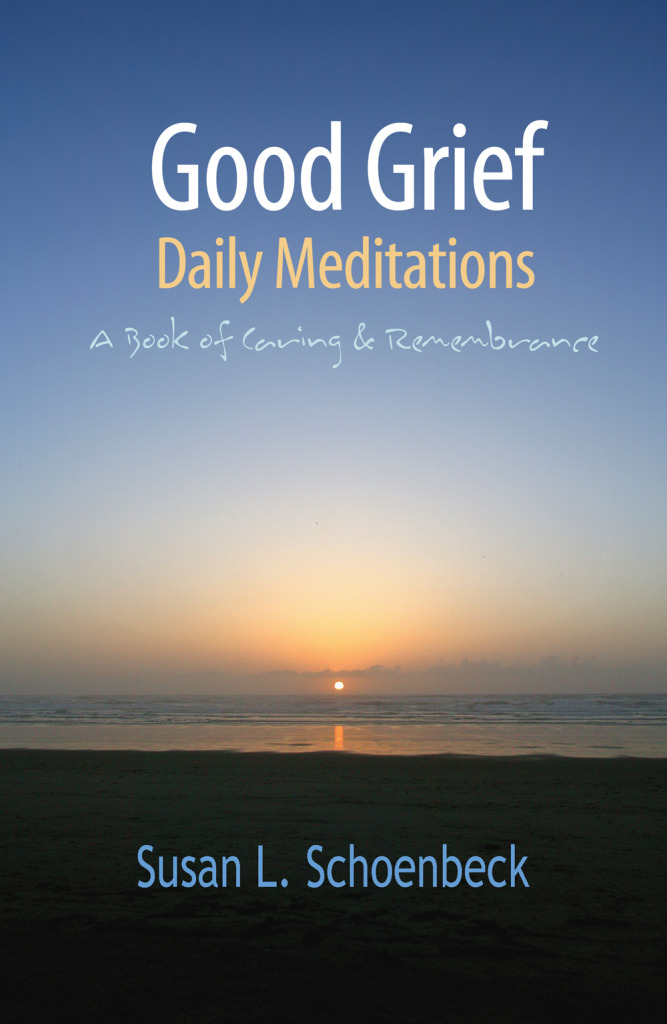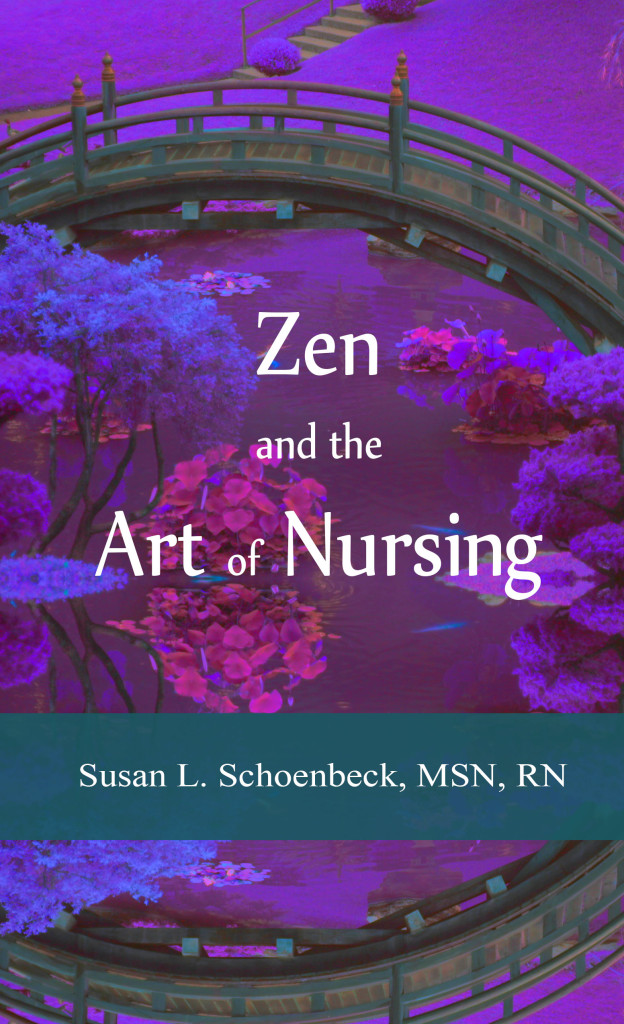Polio Girl: It Only Takes One

Polio Girl Reviews
POLIO GIRL brings the reader into the lives of polio survivors each of whom experienced poliomyelitis in a unique way. The book takes us on a journey through family members’ reactions to polio in their midst, community fear, quarantines, and the disparities in treatment between the wealthy, poor and racial groups.
Struck by polio at age seven months, Susie and her family grappled not only with the unmistakable physical aspects of the disease but also the uncertainty and stigma spawned by societal norms. Schoenbeck’s vivid descriptions of the distinct reactions of her parents and brother, extended family, friends, and teachers throughout her childhood and into adulthood provide insight into not only the devastating acute aspects of polio but also the long-term complications of this illness heretofore not openly discussed.
Schoenbeck’s book, including the extensive well-researched information about polio the disease, is a very important resource for healthcare professionals most of whom have had little or no exposure to polio survivors. POLIO GIRL is a helpful stockpile of information for the over 300,000 people in the United States and 15 million polio survivors worldwide who continue to deal with the long-haul symptoms of polio.
Polio continues to step its footprint in other countries. This book shouts the message that viruses can damage more than is visible.
As an internal medicine physician, I urge doctors to read POLIO GIRL. It is a treasure trove of information that may surprise you and help you understand and help polio survivors.
This book is a dynamic fusion of a survivor's resilience and an artful approach to care delivery. A powerful lesson of understanding wholistic care extends beyond the physical.
People across our planet need this book. It is touching, informational, and inspirational. I will integrate its content into psychology courses I teach and recommend it to professors of other disciplines.
POLIO GIRL reflects how many of us feel when facing seemingly overwhelming circumstances. In challenging, traumatic conditions we can choose to be angry and vengeful, or to be decent and kind.
As I read, my heart and eyes opened further and further to what it means to live with daily pain and disability. The stories help the reader understand the separateness and fear of a child alone without a voice. As a victim of childhood trauma, I heard my own cries. An advocate can make a difference. For polio survivors, that champion could be a nurse, a doctor, a family member, teacher, me, or you.
Information about the sequelae of polio and how to address a polio survivor in a person-centered way, using the tools outlined in the “Toolbox” section, mean this book is an ideal text for nurses, doctors, and ancillary healthcare staff. Professors across the healthcare spectrum will find in POLIO GIRL an understanding of the needs of people who carry with them the burden of viral disease damage.
Polio Girl is a compelling and thought-provoking personal story about a time in our history that has been all but erased by the success of the polio vaccine. The historical information interspersed throughout the story is particularly enlightening.
POLIO GIRL is a must read for health care providers who care for polio patients. This book gives expert patient insight into the paradigm of physical, psychological, and emotional challenges that are faced by poliomyelitis survivors.
POLIO GIRL provides physical therapists with a resource which will increase their understanding of the multifactorial issues polio survivors face. Physical therapists are vital practitioners in helping the 15,000,000 people worldwide who face the long-haul symptoms of suffering poliomyelitis many decades before.
Take a glimpse:
Holding his baby tightly against his chest, Al runs into the darkness to reach the car parked in an alley behind the house. Rain pelts him and he places his jacket over his child to protect her from the sudden downpour on this muggy day.
The doctor told Margie to get Susie to the isolation hospital as soon as possible. Oh my God, I’d better hurry. This cannot be happening.
He lays his daughter on the car’s front seat and then worries she might roll off. He scrunches up an old tarp and stuffs it snugly against her body, so she does not fall over the seat’s edge.
It’s not a traffic jam that has slowed him down. Rather, he misses a turn because his heart and mind are burdened with fear and the ponderous possibility that Susie could have polio. He wants to disbelieve what he knows could be true. Trembling with dread, he must loop back.
The sky darkens as rain intersperses with occasional flashes of lightning when Al arrives at the medical center grounds. A bright lamp illuminates a sign reading Southview Hospital. Shadows made by a canvas canopy overhanging the walkway shade the entrance door from view. He reaches for the doorknob. The latch clicks but does not move. Locked.
Susie coughs and chokes between breaths. Accustomed to the cadence of Al rocking her gently while singing softly, she is frightened by his jerky movements which feel foreign to her.
Alerted by the sound of repeated striking on the door, a tall man dressed in white opens it and beckons Al in with a wave of his hand to a corridor with benches.
A stern-faced woman wearing a nurse’s starched white hat puts out her arms in expectation of taking Susie. Al looks up at the people, but he cannot let go of his precious daughter. He is bewildered. Tapping on Al’s shoulder, the man in white says You must give her up.
Shaken and scared, Al hesitates. The man repeats his direction this time spacing his words deliberately, more slowly. You must…let us…take her. He places one arm around Al’s shoulder in a gesture meant to be reassuring.
The man knows giving up your child to people you do not know is not easy. He says Give me… your child. Dozens of times, he has opened the hospital door to parents seeking help but not wanting to let their children go. Al wonders If I give her to you, what will happen? Where will you take her? Riveted to the ground, he weeps.
The woman wearing the nurse’s hat steps up and lifts his baby into her arms. The tall man and the nurse nod at him but do not smile. Take a seat. We will take good care of her.
Al looks around. His arms and heart are empty. Standing in the corridor, he takes in the sounds and peculiar smells.
Out of the corner of his eye he catches sight of a man and woman nestled in each other’s arms. They are crying. Although they hide their faces on each other’s shoulders, Al recognizes their feelings. Oh my God. This cannot be happening.

Susan L. Schoenbeck, MSN, RN
Susan L. Schoenbeck is a nurse educator with a background in critical care nursing, and leadership positions in continuum of care facilities. She has served as a Director of Nursing and a healthcare administrator. Her unique clinical presence is woven in part from her own hospitalization for polio and also through listening to grieving patients and their families in the role of clinical nurse specialist for death and spiritual care at a metropolitan university hospital. Schoenbeck continues to teach online in a Baccalaureate nursing program. Peer-reviewed national and international journals have published her research.
Good Grief: Daily Meditations
Passages present thought-provoking affirmations and validate the feelings of those who mourn, reminding them they are not alone.
Kent Nerburn: Good Grief: Daily Meditations is an important book. It is also a healing book and God knows we need more of those.
Stephen Kiesling: Susan Schoenbeck is not only a nurse but a teacher of nurses⸺a master of the art of deep listening.
Zen and the Art of Nursing
Nurses may follow pathways not often walked before weaving their healing presence into the lives of others. A nurse’s quiet presence creates a shared safe space where people can utter their deepest emotions without being judged.
This book celebrates nurses and gifts them messages woven with reverence and thankfulness for their care.
Joanne Disch, PhD, RN, FAAN: The readings reminded me of the extraordinarily special relationships we nurses can have with our patients and their families, and the differences that we can make.
Heaven and Angels
This book is written for everyday people who want to learn more about love, forgiveness, and hope. It also serves as a guide for lay ministry.
Rev. D. Timothy Brandt, M. Div. Hospice Chaplain: In Heaven and Angels, author Susan Schoenbeck offers unique insights into what lies beyond physical death, particularly with regard to the wisdom and experience shared from her numerous patients—a reminder that there is so much more beyond treating death as a clinical process. As the author herself states, it is about love, forgiveness, and hope.”
Near-Death Experiences:
Visits to the Other Side
The Final Entrance

Final Entrance is out of print. Near-Death Experiences: Visits to the Other Side is the paperback version of the same.
Bruce Greyson, MD, founding member of International Association for Near-Death Studies: Susan’s message is in part that dying is the most natural thing we do, and that these stories sound strange only to the extent that we try so hard to avoid them. Who is Sue Schoenbeck to tell us this? She is first and foremost a compassionate person with a deep respect for folks struggling with their own “final entrances” and with the deaths of loved ones. She is not only a seasoned clinician and an accomplished teacher but has also won awards for translating medical information into language meaningful and comprehensible to patients and their families.





